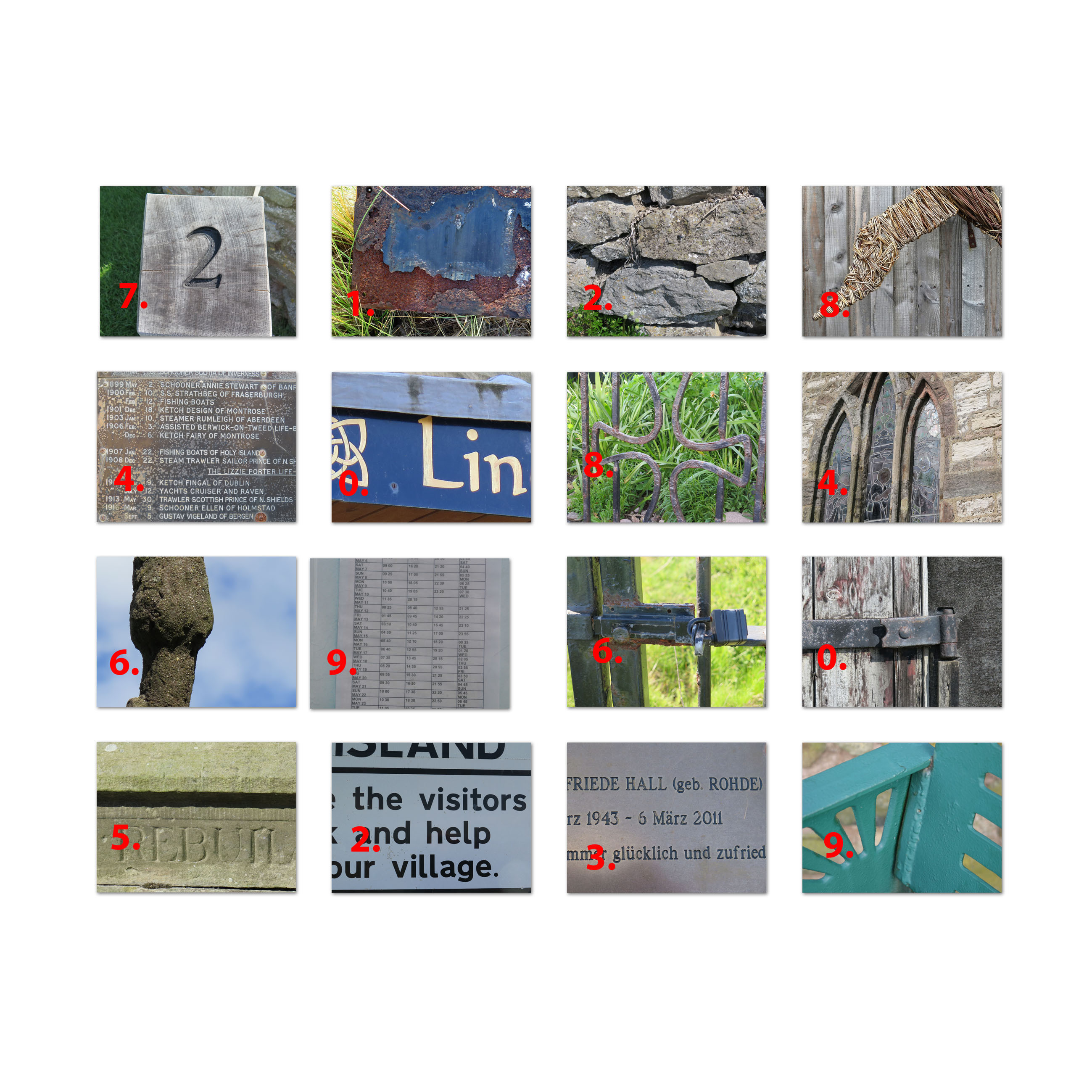The Lindisfarne Gospels book is one of the greatest landmarks of human cultural achievement. Created by the community of St Cuthbert on Lindisfarne it is one of the best examples of creativity and craftsmanship from Medieval times.
On show in Durham University's Palace Green Library between July and September 2013, the centrepiece of the exhibition is the gospel book itself, written in honour of St Cuthbert and displayed alongside his treasures.
The given coordinates will take you to the (chargeable) Car Park on the Island itself. The 8-stage cache will take you on a walk around the island that should take between 3 and 4 hours depending upon both your walking pace and your speed to identify objects at each stage.
At each of the following stages you will be able to identify one of the images on the attached collage. Make a note of the number on the image from that location. These numbers will then provide you with the coordinates for the final location. The final location is 5-10 minutes walk from the village.
At the time of placing the cache holds 25 badges provided by the Lindisfarne Gospels event for the first 25 finders.
In addition, there is a prize for the first person to find both this cache and its cousin - See Lindisfarne Gospels (Durham). Please contact either cache owner to claim your prize. Congratulations to Drew-and-Kaz for the double FTF.

Stage 1. Lindisfarne Heritage Centre N55 40.273 W001 48.102 A good starting point for visits to Holy Island. The centre hosts exhibitions and can provide information about places of interest and local events. A = Photo no. ___
Stage 2. Village Market Place and Village Cross N55 40.207 W001 48.080 A weekly market was held here for many centuries but, by 1860, it had lost its importance and was discontinued not long afterwards. The Celtic cross in the centre of the square was rebuilt in 1828 by John Dobson replacing an older market cross on the same site. The stump of the old cross, now known as the Petting Stone, was moved to a location near the Church where it is used as a traditional part of island wedding ceremonies. B = Photo no. ___
Stage 3. St Aidan’s statue and the Priory N55 40.173 W001 48.065 The monastery established at Lindisfarne by St Aidan was abandoned when the monks left in the the 9th century. Lindisfarne was part of the endowment of the Benedictine monastery at Durham and the building of the Priory was probably started at about the same time as Durham Cathedral in 1093. The church is cruciform in shape and built in the Romanesque style with a vaulted nave, chancel and transept. The monastic buildings included, as well as a cloistered area, a dining hall with a kitchen and brewhouse. An outer court included a guest house for visitors and pilgrims. After the dissolution of the monsteries the Priory gradually decayed to the ruin we see today. C = Photo no. ___
Stage 4. Upturned fishing boats N55 40.209 W001 47.731 The fishermen's stores that we see are made from upturned boats cut in half. The boats were originally Northumbrian cobles, the traditional craft that operated from Holy Island as well as other harbours up and down the coast. Particularly important were herring and at the west end of the nearby harbour stood the smoke house where kippers were produced. D = Photo no. ___
Stage 5. Lindisfarne Castle N55 40.126 W001 47.243 Holy Island Castle was a small fort built in about 1550 using stone from the Priory. Although it lost its importance after the Union of England and Scotland it continued to hold a garrison until 1819. Later in the 19th century it was used by the coastguards. It was bought in 1902 by Edward Hudson, the owner of the magazine Country Life, by which time it was in a very poor condition. The castle as we see it today is very much as a result of the work of the architect, Sir Edwin Lutyens, who completely restored it as a home for Hudson. E = Photo no. ___
Stage 6. The Lough and the bird watching hide N55 40.762 W001 46.962 Fed by a series of springs, The Lough is the only freshwater pool on the island. As well as supplying the village with water it is also home to a variety of birdlife including, coots, moorhens, herons and ducks such as teal and mallard. The co-ordinates are for a hide where birdwatchers can observe the wildlife. F = Photo no. _8_
Stage 7. Emmanuel Head N55 41.152 W001 46.800 The 35 feet high, white-painted stone pyramid was erected by Trinity House in 1810 as a daymarker for the inshore fishing vessels that sailed this part of the Northumberland coastline. Before it was erected this area was particularly dangerous with many shipwrecks and loss of life totalling 700 in just one year in particular. G = Photo no. ___
Stage 8. Site of Green Shiel settlement N55 41.170 W001 48.563 The co-ordinates should bring you to the area of a 9th century Anglo Saxon settlement. It was first discovered in the mid-19th century during the construction of a waggonway to quarries on this part of the island. Excavations in the 1980s identified a group of at least five rectangular buildings with dry-stone footings for, possibly, turf walls. H = Photo no. ___
The final is at N55 4A.BCD W001 4E.FGH
This cache was a joint effort by Jesmond Lynam, Phil100 and Northumbria Biker in conjunction with Just-us-Two for the Lindisfarne Gospels (Durham) Cache.